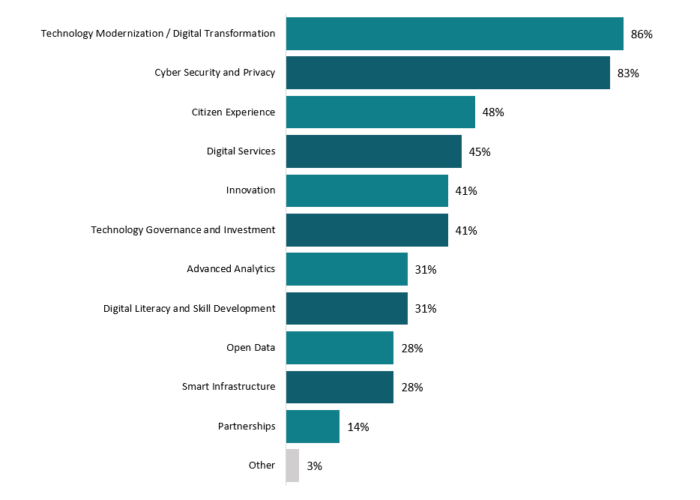Digital transformation has become a necessity to keep up with the rapid pace of savvy citizens. As an enhanced online presence has become a growing priority for local government organizations, many Canadian municipalities have started to shift services and operations to a digital environment. This has come with a need for a robust digital strategy that aligns with the overall corporate strategy as well as Council priorities.
According to a recent MNP survey, 28 percent of municipalities already have a digital strategy in place. The top three focus areas of a digital strategy among respondents include the modernization of technology infrastructure, keeping up with evolving cyber security and privacy risks, and evolving the overall citizen experience.

As municipalities have limited resources there is a need to ensure their digital transformation strategies provide maximum value to all stakeholders. A robust digital transformation strategy includes considerations around governance, investments, resourcing, and optimal timing. Each component of the strategy should consider other corporate priorities and how they work together.
What does a digital transformation strategy look like for a municipality?
Many Canadian municipalities are already becoming leaders in bringing digital innovation and disruption to their business processes and citizen interactions. A digital strategy will often include enhanced government models using Open Data and Smart City initiatives, embracing the digital landscape as a prominent societal hub for citizenship, business, and entertainment. These strategies have common areas of focus:
Citizen Experience and Digital Service Design — What does the citizen want and need and how does that impact the design of digital platforms and interactions?
Digital Access, Literacy, and Inclusion — What is necessary to ensure digital services are accessible to all citizens and that no one is excluded from participation on a digital level?
Data-Driven Decision-Making and Transparency — What does the evidence say about the highest value of digital or technological initiatives?
Connected and Enabling Infrastructure — How can municipalities create a seamless citizen experience across digital channels?
Protecting Privacy and Security — How can the municipality ensure the security and privacy of citizen data?
Municipalities can look to best practices, industry standards, and even analysis of existing data to find answers to the questions above. Every municipality across the country will be at different stages of their digital transformation journeys so other cities and towns won’t always be the best guide. Instead, each municipality should focus on and listen to what their own citizens need and want from their digital experience.
The new citizen experience
The advancement of the civic experience is determined in large part by rising citizen expectations. As expectations continue to shift and technology evolves, municipalities must respond to citizen needs while ensuring effective service delivery and enabling organizational efficiencies.A
In addition, the COVID-19 pandemic forced many organizations to embrace technology to shift services and operations to a digital environment. As a result, citizen expectations are even higher for accessing programs and services through user-friendly, mobile, and convenient digital tools.
Digital transformation in Canadian municipalities should move forward with this new citizen in mind. Many municipalities are prioritizing service delivery transformation in order to streamline the service experience — reducing or removing organizational siloes from the view of the citizen and creating an experience that is holistic and standard for all municipal programs and services.
Personalizing customer experience in digital environments
The new citizen experience requires multiple levels of customization to accommodate a broad range of needs, access, and expectations. At the same time, the citizen experience must also be consistent and integrated across a network of devices and touchpoints.
Good news — the growth of digital channels and new communication technologies increasingly enables organizations to develop and redesign services with a seamless customer experience in mind.
Building this level of citizen care into a digital strategy leads to increased accessibility, relevance, convenience, utilization, and trust in government. A personalized and fully integrated citizen experience, reinforced by advanced analytics, provides an accelerated activation of diverse service channels to support customer demand and ultimately creates significant enhancements for in-person customer service delivery.
Six keys for a seamless and integrated citizen experience
Also known as an omnichannel approach, the personalized citizen experience meets people where they’re at and supports them through various channels along their service journey.
- Consistency — Build a standard and consistent customer experience across channels, including in-person, over the phone, on a mobile or web app, or a combination of multiple channels.
- Integration — Ensure all customer service channels are connected and data and interactions are synchronized. The ability to track customer data and history will provide a 360-degree view of the customer and eliminate the need for the customer to repeat themselves at each touchpoint.
- Accessibility — Provide customers with a variety of channels to access services that meet them where they are and support their unique needs and abilities.
- Personalization — Create a service environment that is welcoming, customer-focused, and enables the organization to provide personalized interactions through a diversity of service channels.
- Digital-first — Leverage technology to enhance the customer service experience through all channels, including understanding how tools, data, and streamlined processes can support an effective customer journey.
- Innovative — Collect, monitor, and analyze customer feedback and behaviour patterns to identify areas for improvement and make continuous improvement updates to service design and delivery.
The importance of cyber security
Of course, all these advancements also come with significant risks. Cyber and privacy breaches are a legitimate threat with any new digital initiative and need to be considered throughout and beyond any new implementation. As these threats continue to evolve, vigilant risk management is imperative.
Cyber security and privacy will be a ubiquitous focus for any organization undergoing a digital transformation strategy. The security of municipal technology, data, and information is critical, as is the information of citizens on any municipality platform. This kind of cyber security awareness and risk management requires reliable partners. The right advisors will:
- Evaluate your existing program and investments
- Create and assist with the development of a prioritized cyber security strategy
- Take compliance and privacy requirements into consideration
- Educate your leaders on the importance of cyber security
Make the most of your digital investment
A strong digital strategy is a necessity for Canadian municipalities. Meeting the rapidly evolving needs and demands of citizens requires strong leadership and effective governance to move innovative initiatives forward while also aligning the entire organization in decision-making.
Remember to prioritize the new citizen experience. Do not wait until everything is “perfect” on the back end to start making public-facing improvements that will reach your citizens. Start tracking metrics including public use of digital services immediately to showcase momentum and also increase learning of what is working and what is not. Be willing to say no to items or requests that are not a priority for the organization as a whole.
This is a journey that looks at more than just your suite of technology solutions and tools — it is a culture shift requiring organizational change and ongoing attention and support.
Want to read the full report?
Download our 2023 Canadian Municipal Digital Transformation Benchmarking Report now for instant access to all the insights and findings.
Connect with us to get started
Our team of dedicated professionals can help you determine which options are best for you and how adopting these kinds of solutions could transform the way your organization works. For more information, and for extra support along the way, contact our team.
